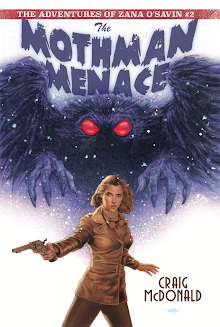The novel finds the actor and author in a race for a lost holy relic promising its possessor infinite power but a ghastly death if lost.
Hector and Orson's competitors in their quest for the "Spear of Destiny" or "Holy Lance" include German occultists, members of the Third Reich, a sensuous Creole Voodoo priestess and a strangely obsessed J. Edgar Hoover.
—Jacket copy for THE GREAT PRETENDER, The Fourth Novel in the Hector Lassiter series.
Readers of the Hector Lassiter series who kept up with various interviews I gave over the years may have rightly been taken by surprise by the announcement and release of THE GREAT PRETENDER in Autumn 2014.
When Betimes Books determined to publish the entire Hector Lassiter cycle, and in something like chronological order, it spurred me to write two additional novels I’d originally contemplated, and even taken cracks at here or there, but hadn’t quite pulled together when the original eight novels were completed between roughly 2006 and 2010.
THE GREAT PRETENDER and DEATH IN THE FACE, featuring respectively, Orson Welles and Ian Fleming, were key to telling Hector’s larger arc as writer and man over the course of the series of novels. They were also the last of the Lassiter novels I wrote in what became a finite, 10-novel cycle. Both were written after a hiatus of a few years of writing about Mr. Lassiter.
The supernatural plays a significant role in THE GREAT PRETENDER: I’d long planned to write something involving Hector and voodoo, maybe set largely in the 1940s and spread over perhaps the French Quarter and Harlem.
But I just couldn’t quite find the hook to hang it all on, until, when preparing the novels for a brisk, Betimes’ publication, I decided Orson Welles required a “Print the Legend”-style treatment that would bring the auteur front-and-center after memorable, extended cameos in HEAD GAMES and TOROS & TORSOS.
PRINT THE LEGEND is my magnum opus on recurring Lassiter “character” Ernest Hemingway; I felt Orson needed a similar deep-dive narrative to fully illustrate his cautionary example, again, ala Hemingway and later, Ian Fleming, for an aging Mr. Lassiter.
It was at that point that I dusted off some go-nowhere drafts of my Lassiter voodoo novel and began to reimagine the tale through a Wellesian prism.
Orson was a very dedicated, and high-end "amateur" magician, as I’d already touched upon in T&T.
He was also a bit of an occultist and a key figure in early-20th Century race relations and its intersection with art, most notably in his all-Black production of Macbeth (popularly referred to as “Voodoo Macbeth” in the day).
Also, as earlier touched upon in TOROS & TORSOS, Welles had dared to pursue an interracial love affair with torch singer Billie Holiday around the time he was shaping CITIZEN KANE.
With Welles firmly in place as Hector’s main foil, and the plot beginning to take shape as it zig-zagged around and through Welles’ heyday successes to his quick-arriving eclipse as a bankable director, more of the plot began to suggest itself.
The novel’s late-1930s setting and use of the Panic Broadcast—an event widely regarded as having been fueled by European war flames that would soon reach America—suggested a Nazi subplot that would transition the series into the next Lassiter book, the World War II-centric ROLL THE CREDITS.
At first glance, Nazis and the occult might not seem like much of a thing outside of a couple of Indiana Jones films.
But George Lucas certainly didn’t invent Nazi fervor for the occult.
Decades before Indiana Jones stole Doc Savage’s act and chased after the Ark of the Covenant, The Thule Society, a loosely described “German study group" that cherished all things “Aryan” also embraced “esoteric studies” and “lost” relics collection.
The Thule Society also required recruits to sign an oath assuring, “"The signer hereby swears to the best of his knowledge and belief that no Jewish or coloured blood flows in either his or in his wife's veins, and that among their ancestors are no members of the coloured races."
Not so surprisingly, the Thule Society became a foundational organization for the eventual Nazi party.
While Adolph Hitler might not have been much of an occultist himself, several of his key henchman emphatically did embrace the supernatural.
Orson Welles.
Nazis.
The occult.
These are the spooky engines propelling THE GREAT PRETENDER.
You can read the first chapter here.
(Mr. Welles will also be a strong presence in the forthcoming, HEAD GAMES: THE GRAPHIC NOVEL, coming Oct. 21 from First Second Books.)









































No comments:
Post a Comment